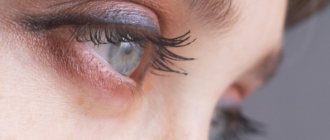Why do eyes become dry?
Redness of the white of the eye, burning, dryness, discomfort, photophobia are a response to disruption of the stability of the tear film, which moisturizes the conjunctiva and cornea.
Dryness can be caused by autoimmune and endocrine diseases, long-term use of certain medications, vitamin deficiency, and connective tissue diseases. Sometimes discomfort appears when wearing lenses and long-term treatment of ophthalmological diseases. But in most cases, xerophthalmia is a consequence of prolonged visual stress (working at a computer, driving in conditions of limited visibility, reading books, etc.).
Prevention
- To prevent dry eyes, you should consume at least one and a half liters of water per day.
- Nutrition must be balanced and include the required amount of microelements and vitamins.
- When working with dangerous machinery or engaging in extreme sports, you must wear eye protection.
- In sunny weather, it is recommended to wear glasses that will protect against ultraviolet radiation.
- You should follow the rules of working at the computer and rest every 40 minutes of work.
- Timely treatment of etiological diseases and proper use of contact lenses significantly reduces the likelihood of developing the disease.
Now you know what folk remedies can be used to treat dry eyes. Before using a folk remedy for dry eyes, you should consult your doctor. We hope this information was useful and interesting.
Folk remedies for dry eyes
If signs of keratoconjunctivitis appear, you should definitely consult a doctor. He will prescribe a course of therapy that will help get rid of the problem. But most often, patients prefer to self-medicate, attributing this decision to the lack of time to go to a specialist.
To treat dry eye syndrome, the following folk remedies are usually used:
- Sea buckthorn oil. Apply to the upper eyelid to moisturize the conjunctiva.
- Chamomile decoction. It is believed to soothe irritated skin and relieve inflammation.
- A decoction of a mixture of rosemary and pansy herbs. It is believed to have a calming effect.
- Green tea. Used as cold and warm compresses to eliminate the unpleasant symptoms of xerophthalmia.
- Lavender oil. Stimulates blood circulation, promotes rapid restoration of damaged tissues. Has a bactericidal and antiseptic effect.
- Ghee. This folk remedy for eye treatment is usually used during massage. It helps eliminate discomfort and soothes irritated skin.
In some cases, adherents of traditional medicine prefer to use cucumber juice, mint decoction and even honey to combat the unpleasant symptoms of xerophthalmia. But is it effective?
Dry eye syndrome - treatment
How to treat dry eye? Treatment for dry eye syndrome includes the following:
1. Remove the provoking factor; 2. Drug treatment; 3. Additional treatment; 4. Surgical treatment; 5. Treatment of concomitant diseases.
Remove the provoking factor
Sometimes treatment for dry eye syndrome comes down to just removing its cause. If the body is healthy, then even a regular vacation at a distance from the computer and isolating the laptop, tablet, TV, can normalize the functioning of tear secretion. It’s easy to check - just limit yourself from work and using this equipment for a couple of days, and if the symptoms go away, then a vacation is exactly what you need.
In addition, office work requires exercise for the eyes. Doctors note that when a person works at a computer, he blinks much less/less often
If you pay attention to this and train yourself to blink more often during work, periodically rest and do eye exercises, the symptoms of “dry eye” will be minimized or even go away
You should also ensure timely wet cleaning in your work or living space, cleaning the air conditioner, and maintaining normal humidity and air temperature.
A very useful device for combating dry air is an air humidifier, especially important during the heating season.
Drug treatment
Drug treatment for dry eye syndrome is aimed at stimulating tear production, improving its quality and retaining tears on the surface of the eye for a long time.
For the above purposes, eye drops for dry eyes are usually used, among which are “Vidisik”, “Vizmed”, “Artificial tear”, “Okovirin”, “Optiv”, “Oftolik”, “Lacrisify”, “Hilo-chest of drawers” .
If you have contact lenses, be sure to follow the wearing regime.
To eliminate irritation from wearing contact lenses, you can use the following drops - “Licontin”, “Hilozar-comod”.
Each product has its own dosage, indications and contraindications, so before use, consult your doctor and carefully read the instructions for use.
To treat dry eye syndrome, eye ointments are also used, which are usually placed under the eyelid before bed.
Additionally, it is recommended to consume vitamin A (retinol) and Omega-3 fatty acids.
In some cases, the use of steroids, immunosuppressants (Cyclosporine), and hormonal drugs is prescribed.
For “dry eye” due to eye infection, antibacterial ointments are used.
Additional treatment
Additional treatments for dry eye syndrome include:
- Wearing scleral lenses are large contact lenses that create a “storage” for tears on the cornea and prevent the accelerated evaporation of tear fluid from the surface of the eye. Such lenses also protect the eye from adverse external factors.
- Wearing safety glasses - act as a humidification chamber, partially covering the area around the eyes. Can be made in the form of safety glasses, glass, bandages, caps.
- Wearing special eye prostheses.
Surgery
The lack of the required effect with drug treatment can lead to surgical methods of treating dry eye:
Tarsorrhaphy - a treatment method based on partial suturing of the eyelids, which reduces the palpebral fissure and helps reduce the evaporation of tear fluid;
Blocking the outflow of tears - is based on partial or complete blocking of the tear ducts, through which excess tear fluid is removed from the cornea. Blocking is carried out by inserting punctal plugs into the duct or burning them.
Treatment of concomitant diseases
If the cause of “dry eye” lies in the presence of other diseases, then appropriate treatment is prescribed by an appropriate specialized specialist. Careful diagnosis for symptoms of dry eye syndrome is very important, otherwise all of the above actions can only give a temporary effect.
Can homemade recipes help with dry eyes?
Xerophthalmia is a serious disease that, if left untreated, can progress and lead to the development of complications (corneal ulcer, filamentous keratitis, etc.). Therefore, to prevent this, it is better to give preference to official medicine rather than try to restore the health of the visual organ with folk recipes.
At home, you can only use those products recommended by your doctor. Usually these are eye drops or other ophthalmic drugs, the action of which is aimed at eliminating the root cause of the pathological condition. Treatment of dry eye with folk remedies is not justified, since it most often leads to the development of serious complications:
- Progression of the pathological process. Insufficient therapy often leads to the disease progressing rapidly. Against the background of this process, concomitant pathologies often develop.
- Allergic reactions. Plant raw materials, which are used to prepare “homemade” remedies for xeophthalmia, have a high degree of allergenicity. Therefore, using a regular decoction of chamomile or sage can result in itching, swelling, and redness of blood vessels. Against this background, their condition will only worsen.
Perhaps traditional medicine for the eyes can be useful, but not in a situation where serious diseases occur. Treatment of ophthalmological pathologies should be agreed with a doctor and prescribed only after a thorough diagnosis.
Professional therapy of eye pathologies
As prescribed by a doctor, ophthalmic solutions can be used to eliminate the symptoms and causes of dry eyes. They help get rid of burning, itching, and help moisturize the conjunctiva.
To eliminate discomfort, vitamin, antihistamine, antiseptic, moisturizing, and antibacterial drugs can be used. They can have a liquid consistency (have a short-term therapeutic effect) or a gel (longer moisture retention, but may cause some discomfort).
Doctors do not recommend using folk remedies for eye treatment. They are not able to eliminate the causes of xerophthalmia, therefore, with the use of decoctions and lotions, the disease will progress.
In advanced cases, surgical treatment of the disease may be required. Intervention is indicated if there is a high risk of corneal ulceration or perforation. The essence of the operation usually comes down to blocking the tear ducts in order to reduce the outflow of tears.
Delfanto® – moisturizing the eyes with your own tears
For the treatment and prevention of dry eye syndrome, the modern drug Delfanto® can be used. It is widely used in foreign practice, and relatively recently appeared on the Russian market.
The basis of Delfanto® capsules is the standardized MaquiBright® extract, which contains at least 35% antioxidants. Active components help the organ of vision fight the effects of oxidative stress. They contribute to:
- restoration of damaged cells of the lacrimal glands;
- normalization of tear secretion production;
- natural and stable hydration of the surface of the cornea and conjunctiva.
Delfanto® capsules are recommended for people whose activities involve increased visual stress. They can be used together with ophthalmic solutions, but after a few weeks there is no need to use drops.
To get rid of dryness or discomfort, it is enough to take 1-2 Delfanto® capsules per day. The product has some contraindications, so before starting a course of therapy you should consult an ophthalmologist.
Symptoms
The severity of clinical symptoms largely depends on the severity of the disease. As is correct, a person complains of unpleasant dry eyes. It also does not tolerate wind, air conditioning, or smoke well. As a rule, in response to irritating factors, the patient experiences profuse lacrimation.
The following symptoms may indicate dry eye syndrome:
- pain, burning, discomfort in the eyes;
- feeling of sand in the conjunctival cavity;
- fear of bright light;
- decreased visual acuity at the end of the working day;
- redness and swelling of the conjunctiva, the appearance of mucous discharge.
Due to prolonged dryness of the anterior part of the eyeball, a person's cornea is damaged. The appearance of filamentous keratitis, erosions of the cornea, and dry keratoconjunctivitis is possible. Some patients develop conjunctivochalasis - creeping of the conjunctiva onto the lower edge of the eyelid.










